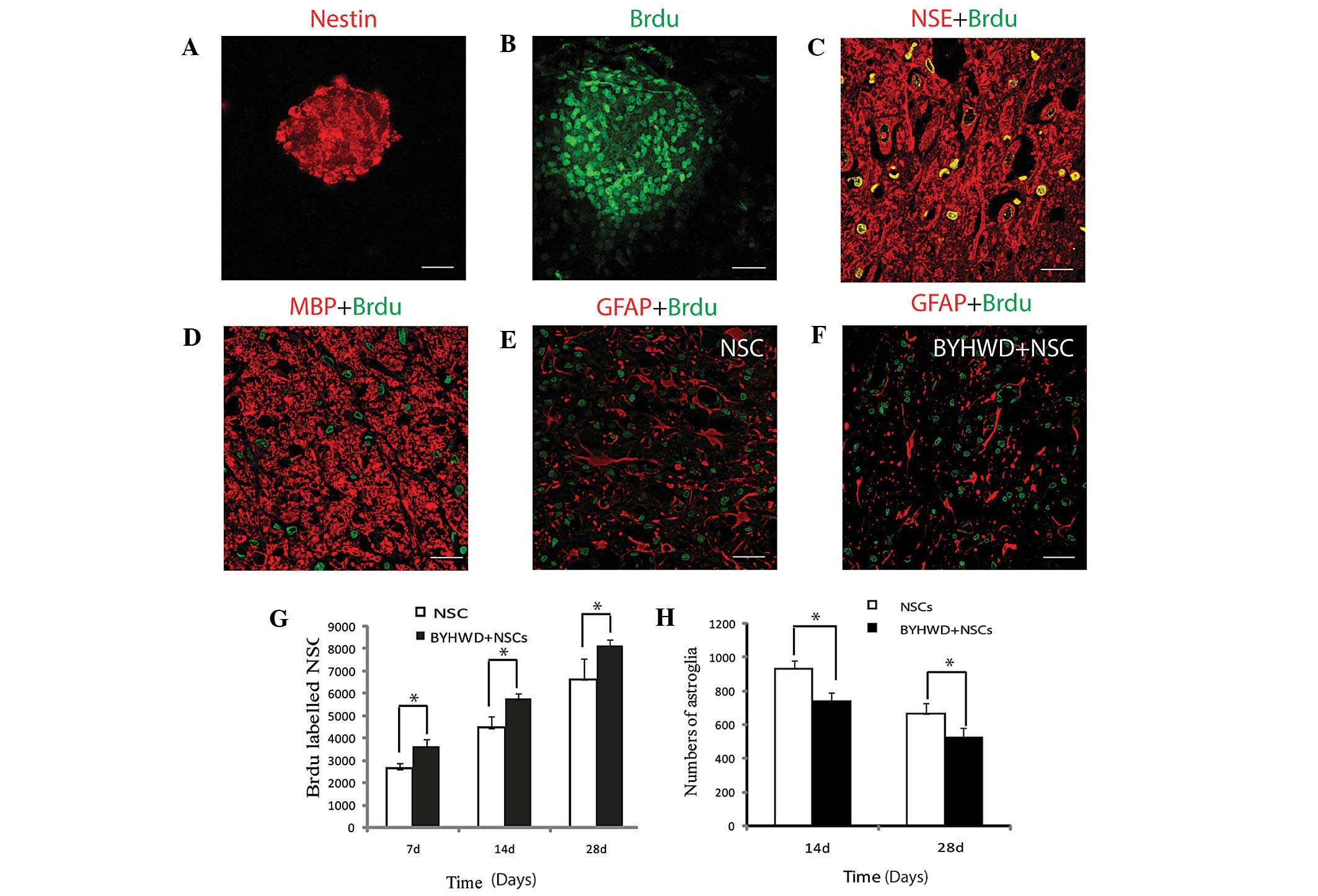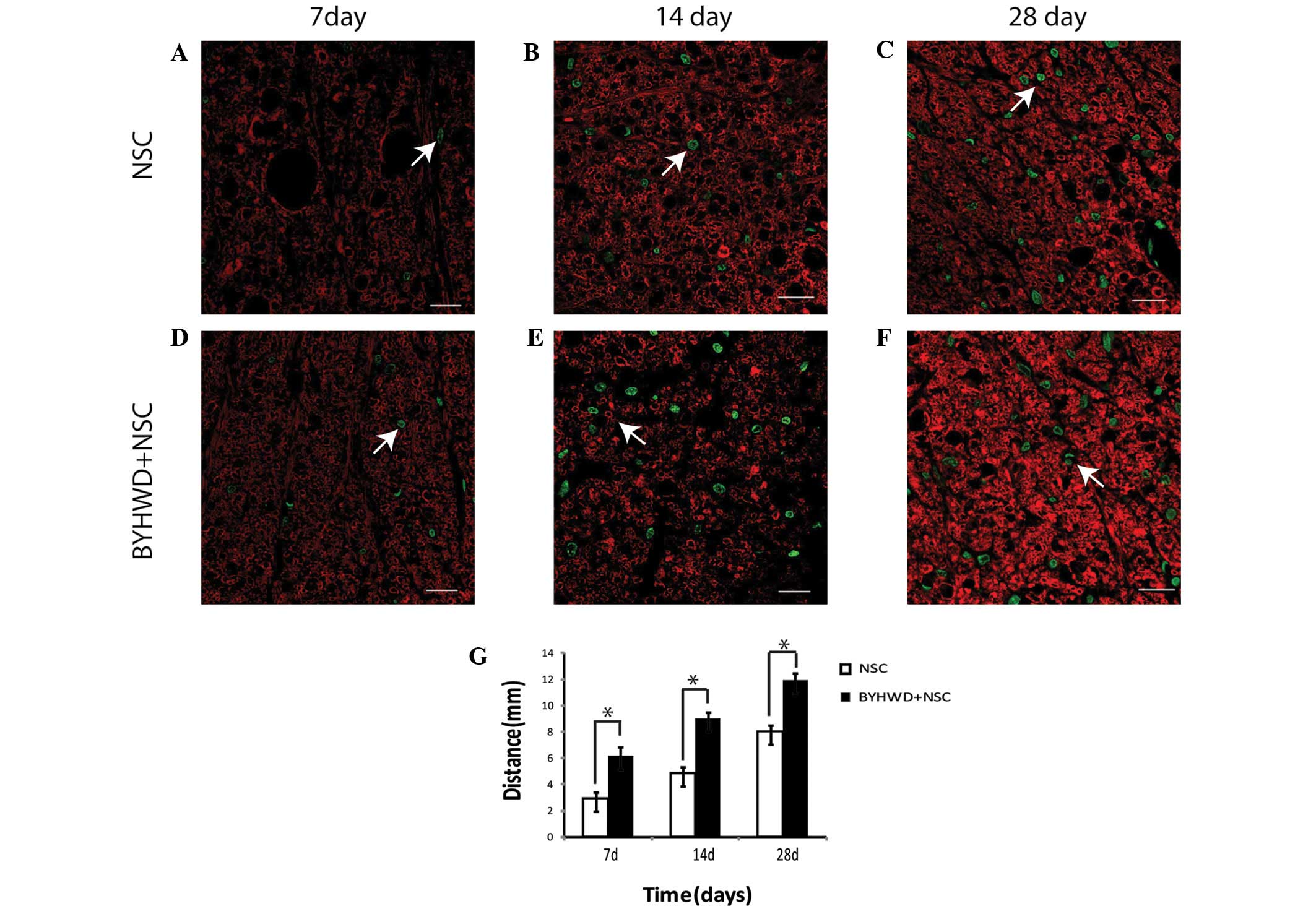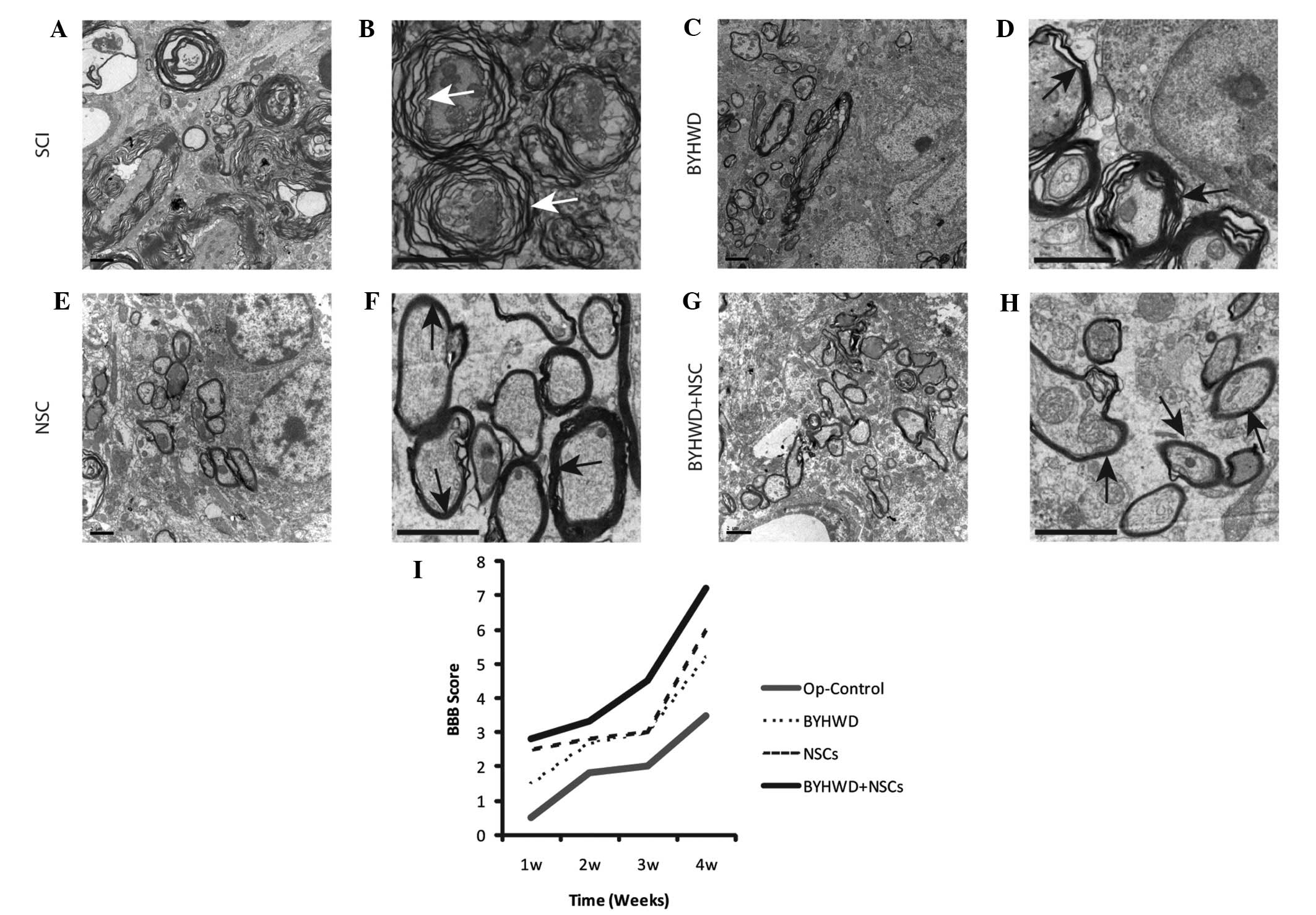|
1
|
Björklund A and Lindvall O: Cell
replacement therapies for central nervous system disorders. Nat
Neurosci. 3:537–544. 2000. View
Article : Google Scholar : PubMed/NCBI
|
|
2
|
Cummings BJ, Uchida N, Tamaki SJ, et al:
Human neural stem cells differentiate and promote locomotor
recovery in spinal cord-injured mice. Proc Natl Acad Sci USA.
102:14069–14074. 2005. View Article : Google Scholar : PubMed/NCBI
|
|
3
|
Reynolds BA and Weiss S: Generation of
neurons and astrocytes from isolated cells of the adult mammalian
central nervous system. Science. 255:1707–1710. 1992. View Article : Google Scholar : PubMed/NCBI
|
|
4
|
Marques SA, Almeida FM, Fernandes AM, et
al: Predifferentiated embryonic stem cells promote functional
recovery after spinal cord compressive injury. Brain Res.
1349:115–128. 2010. View Article : Google Scholar : PubMed/NCBI
|
|
5
|
McDonald JW, Liu XZ, Qu Y, et al:
Transplanted embryonic stem cells survive, differentiate and
promote recovery in injured rat spinal cord. Nat Med. 5:1410–1412.
1999. View Article : Google Scholar : PubMed/NCBI
|
|
6
|
Teng YD, Lavik EB, Qu X, et al: Functional
recovery following traumatic spinal cord injury mediated by a
unique polymer scaffold seeded with neural stem cells. Proc Natl
Acad Sci USA. 99:3024–3029. 2002. View Article : Google Scholar : PubMed/NCBI
|
|
7
|
Vroemen M, Aigner L, Winkler J and Weidner
N: Adult neural progenitor cell grafts survive after acute spinal
cord injury and integrate along axonal pathways. Eur J Neurosci.
18:743–751. 2003. View Article : Google Scholar : PubMed/NCBI
|
|
8
|
Namiki J and Tator CH: Cell proliferation
and nestin expression in the ependyma of the adult rat spinal cord
after injury. J Neuropathol Exp Neurol. 58:489–498. 1999.
View Article : Google Scholar : PubMed/NCBI
|
|
9
|
Rietze R, Poulin P and Weiss S:
Mitotically active cells that generate neurons and astrocytes are
present in multiple regions of the adult mouse hippocampus. J Comp
Neurol. 424:397–408. 2000. View Article : Google Scholar : PubMed/NCBI
|
|
10
|
Yamanaka H, Obata K, Kobayashi K, Dai Y,
Fukuoka T and Noguchi K: Alteration of the cell adhesion molecule
L1 expression in a specific subset of primary afferent neurons
contributes to neuropathic pain. Eur J Neurosci. 25:1097–1111.
2007. View Article : Google Scholar : PubMed/NCBI
|
|
11
|
Kamei N, Tanaka N, Oishi Y, et al: BDNF,
NT-3, and NGF released from transplanted neural progenitor cells
promote corticospinal axon growth in organotypic cocultures. Spine
(Phila Pa 1976). 32:1272–1278. 2007. View Article : Google Scholar
|
|
12
|
Pearse DD, Sanchez AR, Pereira FC, et al:
Transplantation of Schwann cells and/or olfactory ensheathing glia
into the contused spinal cord: Survival, migration, axon
association, and functional recovery. Glia. 55:976–1000. 2007.
View Article : Google Scholar : PubMed/NCBI
|
|
13
|
Hu YF, Zhang ZJ and Sieber-Blum M: An
epidermal neural crest stem cell (EPI-NCSC) molecular signature.
Stem Cells. 24:2692–2702. 2006. View Article : Google Scholar : PubMed/NCBI
|
|
14
|
Lepore AC, Walczak P, Rao MS, Fischer I
and Bulte JW: MR imaging of lineage-restricted neural precursors
following transplantation into the adult spinal cord. Exp Neurol.
201:49–59. 2006. View Article : Google Scholar : PubMed/NCBI
|
|
15
|
Reier PJ: Cellular transplantation
strategies for spinal cord injury and translational neurobiology.
NeuroRx. 1:424–451. 2004. View Article : Google Scholar
|
|
16
|
Conti L, Pollard SM, Gorba T, et al:
Niche-independent symmetrical self-renewal of a mammalian tissue
stem cell. PLoS Biol. 3:e2832005. View Article : Google Scholar : PubMed/NCBI
|
|
17
|
Wang QR: Yilin Gaicuo (Correction on
Errors in Medical Classics). 2. 1st edition. People’s Medical
Publishing House; Beijing: pp. 362005
|
|
18
|
Fan L, Wang K and Cheng B: Effects of
buyang huanwu decoction on apoptosis of nervous cells and
expressions of Bcl-2 and bax in the spinal cord of
ischemia-reperfusion injury in rabbits. J Tradit Chin Med.
26:153–156. 2006.PubMed/NCBI
|
|
19
|
Li XM, Bai XC, Qin LN, Huang H, Xiao ZJ
and Gao TM: Neuroprotective effects of Buyang Huanwu Decoction on
neuronal injury in hippocampus after transient forebrain ischemia
in rats. Neurosci Lett. 346:29–32. 2003. View Article : Google Scholar : PubMed/NCBI
|
|
20
|
Qu HD, Tong L and Shen JG: Effect of
buyang huanwu decoction drug serum on expression of p53 and p21
genes in cultured rat’s cerebral cortical neuron after hypoxia in
vitro. Zhongguo Zhong Xi Yi Jie He Za Zhi. 24:133–135. 2004.(In
Chinese). PubMed/NCBI
|
|
21
|
Tang YH, Li H and Chen BY: Effect of
active fraction of buyang huanwu decoction on caspase expression in
rats after focal cerebral ischemic reperfusion. Zhongguo Zhong Xi
Yi Jie He Za Zhi. 26:533–537. 2006.(In Chinese). PubMed/NCBI
|
|
22
|
Cheng YS, Cheng WC, Yao CH, et al: Effects
of buyang huanwu decoction on peripheral nerve regeneration using
silicone rubber chambers. Am J Chin Med. 29:423–432. 2001.
View Article : Google Scholar
|
|
23
|
Chen A, Wang H, Zhang J, et al: BYHWD
rescues axotomized neurons and promotes functional recovery after
spinal cord injury in rats. J Ethnopharmacol. 117:451–456. 2008.
View Article : Google Scholar : PubMed/NCBI
|
|
24
|
Sun J, Bi Y, Guo L, et al: Buyang Huanwu
Decoction promotes growth and differentiation of neural progenitor
cells: using a serum pharmacological method. J Ethnopharmacol.
113:199–203. 2007. View Article : Google Scholar : PubMed/NCBI
|
|
25
|
Chai Y, Yang C, Shi ZG, Zhang LX and Zhang
M: The cultivation and identification of neural stem cells from
spinal cord of embryonic rat. Shen Jing Jie Pou Xue Za Zhi.
25:339–342. 2009.(In Chinese).
|
|
26
|
Zhang XR, Guo GH, Liu DW and Peng Y:
Separation, culture and BrdU labeling of human bone marrow
mesenchymal stem cells. Zhongguo Zu Zhi Gong Cheng Yan Jiu Yu Lin
Chuang Kang Fu. 1319:3618–3622. 2009.(In Chinese).
|
|
27
|
China Pharmacopoeia Commission.
Pharmacopoeia of the People’s Republic of China (Part I).
Supplement 8:1. 1st edition. Chemical Industry Press; Beijing: pp.
2672000
|
|
28
|
Zhang J, Li C, Guo X and Wang G: Effect of
buyang huanwu decoction on platelet activating factor content in
arterial blood pre- and post-arterial thrombosis in rats. J Tradit
Chin Med. 21:299–302. 2001.
|
|
29
|
Ministry of Science and Technology of the
People’s Republic of China. Guiding principles of care. http://www.most.gov.cn/fggw/zfwj/zfwj2006/200609/t20060930_54389.htmuri.
Accessed July 3, 2012
|
|
30
|
National Institutes of Health Guide for
the Care and Use of Laboratory Animals. 8th edition. http://grants.nih.gov/grants/olaw/Guide-for-the-care-and-use-of-laboratory-animals.pdfuri.
Accessed July 3, 2012
|
|
31
|
Chen BY, You SW and Wang Y: Post-operative
care measures of transected rat spinal cord. Shiyan Dongwu Kexue yu
Guanli. 17:55–56. 2000.(In Chinese).
|
|
32
|
Basso DM, Beattie MS and Bresnahan JC: A
sensitive and reliable locomotor rating scale for open field
testing in rats. J Neurotrauma. 12:1–21. 1995. View Article : Google Scholar : PubMed/NCBI
|
|
33
|
Lu J, Sun WY and Chen DY: Preparation of
immunofluorescence double staining sample for laser confocal
microscope. Mian Yi Xue Za Zhi. 23:344–345. 3502007.(In
Chinese).
|
|
34
|
Hamasaki T, Tanaka N, Kamei N, et al:
Magnetically labeled neural progenitor cells, which are localized
by magnetic force, promote axon growth in organotypic cocultures.
Spine (Phila Pa 1976). 32:2300–2305. 2007. View Article : Google Scholar
|
|
35
|
Karimi-Abdolrezaee S, Eftekharpour E, Wang
J, Morshead CM and Fehlings MG: Delayed transplantation of adult
neural precursor cells promotes remyelination and functional
neurological recovery after spinal cord injury. J Neurosci.
26:3377–3389. 2006. View Article : Google Scholar : PubMed/NCBI
|
|
36
|
Kang E, Wu G, Ma H, Li Y, Tippner-Hedges
R, Tachibana M, Sparman M, Wolf DP, Schöler HR and Mitalipov S:
Nuclear reprogramming by interphase cytoplasm of two-cell mouse
embryos. Nature. 509:101–104. 2014. View Article : Google Scholar : PubMed/NCBI
|
|
37
|
Yang D, Cai S, Liu H, Guo X, Li C, Shang
M, Wang X and Zhao Y: On-line identification of the constituents of
Buyang Huanwu decoction in pig serum using combined HPLC-DAD-MS
techniques. J Chromatogr B Analyt Technol Biomed Life Sci.
831:288–302. 2006. View Article : Google Scholar : PubMed/NCBI
|

















